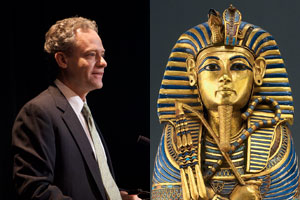Alumni
Amid Pharaohs, Presidents: National Geographic VP ’75 Serves on Oil Spill Commission

Terry Garcia, SIS/BA ’75, and King Tut.
The oil spill in the Gulf of Mexico on April 20, 2010 affected multitudes of people and set into motion a ripple effect. For Terry Garcia, SIS/BA ’75, it brought a new opportunity to serve that he couldn’t turn down.
“I got a message asking me to call the White House - that it was urgent. I called back and was given the details,” he says. With that call, Garcia, executive VP of Mission Programs for the National Geographic Society, became one of seven people to form the new National Commission on the BP Deepwater Horizon Oil Spill and Offshore Drilling.
“I’m honored to have been selected. I take it seriously; it is a huge responsibility,“ he said. “There’s only one answer when you get such a call - you accept and live up to its responsibilities.”
The Commission held its first public hearings in New Orleans on July 12. Those hearings were preceded by Commissioner Visits to witness the impact of the spill on the Gulf States. Garcia and former U.S. Senator Bob Graham (D-FL), the committee’s cochair, started in Panama City, Florida, before travelling to New Orleans. “You can’t fully appreciate the financial and emotional impact on the community fully without seeing it firsthand,” he says.
These areas have gotten “a double-whammy” between Katrina and now the spill, he says. Local budgets are stretched and officials need to dip into emergency funds. There’s a spike in unemployment and a drop in tourism, and now hurricane season is here. All of these factors combined have created devastating effects. There will be more hearings and an intensive investigation carried out over the next six months through January 2011.
Garcia has previous experience with oil spills. He was appointed in 1994 by President Clinton as general counsel to the National Oceanic and Atmospheric Administration (NOAA), which led efforts to create a restoration plan for the Prince William Sound and the Gulf of Alaska, following the Exxon Valdez oil spill.
As one door closes, another opens.
When President Clinton’s term ended, so did Garcia’s administration post. He wondered briefly if he should return to Los Angeles, where he had practiced law for 14 years prior to his government work, but his dedication to conservation caught the attention of the National Geographic Society. Founded in 1888, the society’s mission is to “inspire people to care about the planet.”
Since 1999, Garcia has overseen the society's core mission programs, including programs that support and manage more than 400 scientific field research, conservation, and exploration projects annually. Garcia notes that there is much left to explore. “I think the 21st century is going to be the greatest age of discovery in the history of the human race. Doors closed for centuries are now being opened, thanks to advancements in technology. Take the ocean, for example. Seventy percent of the earth’s surface is covered by ocean and every second breath we take comes straight from the oxygen generated from the ocean, yet we’ve only explored maybe 5 percent.”
Most recently, Garcia was instrumental in bringing the exhibition "Tutankhamun and the Golden Age of the Pharaohs" to the United States (now open in New York City and Denver). He notes with pride that this is the first time in history Egypt will profit from an exhibition. The proceeds will have a lasting legacy: funding the construction of the Grand Egyptian Museum in Cairo, now in progress.
Garcia is also responsible for the five-year Genographic Project that will map the history of human migration using genetic science. “I’m particularly proud of this global research project, designed to investigate how we populated the planet. Through this project, we are also offering the public an opportunity to participate in the research by submitting DNA samples obtained with a cheek swab kit that can be purchased for $99.”
Garcia has always thought big—world history, protecting our planet—but his efforts started at AU. “I got my first big break when SIS assistant dean Steve Arnold helped me get an internship at the U.N. Association in 1973, which helped me to get involved in international work,” he says. “That little internship allowed me to move on and do so much more.”

